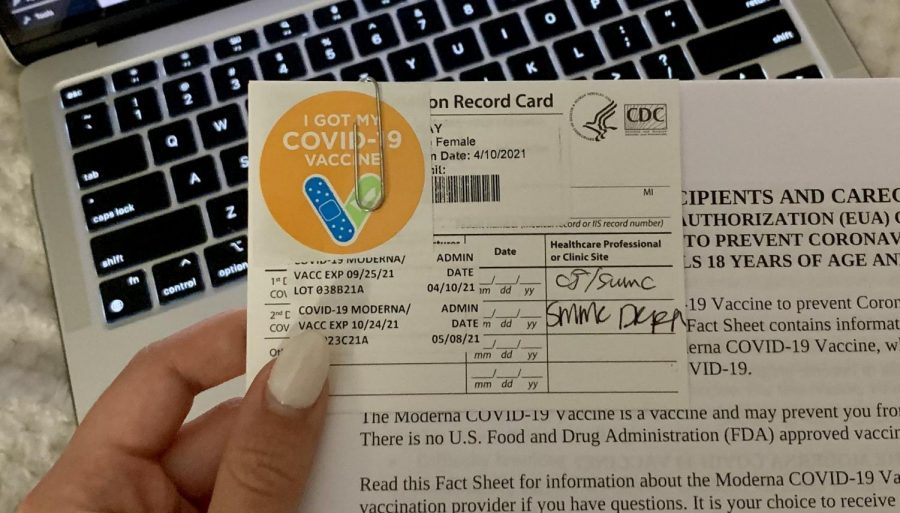Moderna & Pfizer & Johnson and Johnson, Oh My!
An examination of the current pace of COVID vaccines – who is able to get it, who has it, what can we expect for the future?
Vaccination card for the Moderna vaccine.
With the COVID-19 pandemic reigning on for over a year, finally a light at the end of the tunnel has appeared in the form of a two-dose – or even a single-dose – shot.
The three major contenders for the COVID-19 vaccine have been that of Pfizer and Moderna, two two-dose shots, and that of Johnson and Johnson, a single-dose shot.
Pfizer
The Pfizer vaccine, a two-dose shot with 21 days between shots (with two weeks after the second dose marking you fully vaccinated), was manufactured by the oncology-focused German biotechnology company, BioNTech, and their partnership with Pfizer, a pharmaceutical company with values in providing “access to medicines that are safe, effective, and affordable.”
According to the Center for Disease Control and Prevention, more commonly referred to as the CDC, the Pfizer vaccine has been approved for use in those 12-years-old and over – making it highly accessible to the public. The vaccine was determined to be 95% effective against the COVID-19 illness.
Side effects listed by the CDC included pain, redness, and swelling in the arm of the shot as well as fatigue, nausea, chills, fever, and pain in muscles as well as headaches.
“[With the] first dose I didn’t have any side effects, [but with the] second dose I had a fever and bad chills,” reported Central Kitsap High School senior, Alayna Kisiday, on receiving the Pfizer vaccine.
Kisiday supplemented her statement by stating that she believes “everyone should get it.”
Moderna
The Moderna vaccine – a dual-dose similar to the Pfizer vaccine, with 28 days between shots and a two week waiting period – was manufactured by the biotechnical and pharmaceutical Moderna Therapeutics, a company with an emphasis on using Messenger RNA to train “patient’s own cells to produce proteins that could prevent, treat, or cure disease.”
The CDC states that the Moderna vaccine is recommended for those 18 and older, making the shot slightly less available to the population but still largely accessible. The Moderna vaccine is highly effective, ranking just below Pfizer with a rate of being 94.1% effective against the COVID-19 illness.
The side effects listed for the Pfizer vaccine are the same as those listed for the Moderna vaccine.
In personal experience, I received the Moderna vaccine. My first dose was given on April 10 and my second dose was given on May 8 – both were received at the St. Michael Medical Center in Silverdale.
Upon arrival for both shots, I was required to fill out paperwork consenting to receiving the vaccine and was made aware of the possible side effects to the vaccine. Following the shot, I was then required to sit in a waiting room for observation for 15 minutes before leaving.
The side effects I experienced were a manageable headache following my first dose, and I was able to carry out my usual day-to-day tasks with little disruption.
The side effects following the second dose were stronger, I was fine for the first few hours following the shot but later experienced chills accompanied by a fever and muscle pain.
Fortunately, these side effects only lasted roughly 24 hours – as predicted by the warnings given before receiving the vaccine. I was determined to be “fully-vaccinated” two weeks after receiving the second dose.
Johnson & Johnson
The Johnson & Johnson vaccine is the single-dose option against the COVID-19 illness. The vaccine was manufactured by Janssen Pharmaceuticals, under the parent company of Johnson & Johnson.
The CDC states that the vaccine is recommended for those 18 and older but advises a warning to women aged 50 and younger, “…women younger than 50 years old especially should be aware of the rare risk of blood clots with low platelets after vaccination, and that other COVID-19 vaccines are available where this risk has not been seen.”
Side effects listed regarding the Johnson & Johnson vaccine are similar to those listed for the aforementioned options. The vaccine, as tested in clinical trials, was proven to be 66.3% effective – ranking below both Pfizer and Moderna.
With vaccinations growing more and more available to the public, there is a beacon of hope for a healthier and brighter future.



